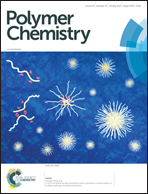A new thermoresponsive polymer of poly(N-acryloylsarcosine methyl ester) with a tunable LCST†
Abstract
Poly(N-acryloylsarcosine methyl ester) (PNASME), a thermoresponsive N-ester substituted polyacrylamide that has a well-defined molecular weight and a low Đ, was synthesized by solution RAFT polymerization. The synthesized PNASME exhibited a cloud point temperature (Tcp) or lower critical solution temperature (LCST) of 44.0 °C. It was found that various factors could affect the Tcp of PNASME, e.g., the polymer molecular weight, the polymer concentration, the salt effect on Tcp following the order of the Hofmeister series, urea induced increasing Tcp, and phenol induced decreasing Tcp. The mechanism of urea and phenol inducing the phase transition of PNASME was revealed by 2D NOESY spectroscopy, and how the hydrogen bonding between PNASME and the solutes of urea and phenol affected the phase transition of PNASME was clarified. The contrary effect on the Tcp of PNASME induced by urea and phenol makes it easy to adjust the thermoresponse of PNASME, and the tunable thermoresponse of the diblock copolymer of poly(N-acryloylsarcosine methyl ester)-block-poly(N-isopropylacrylamide) was demonstrated. The present study is believed to offer a new route to tune the solution behavior of thermoresponsive polymers.



 Please wait while we load your content...
Please wait while we load your content...